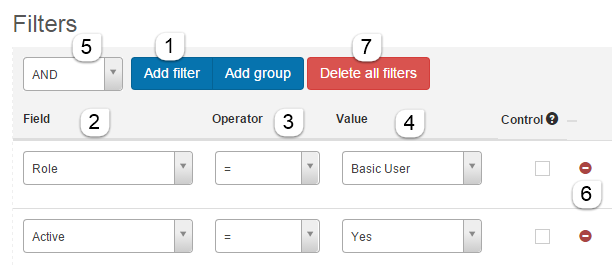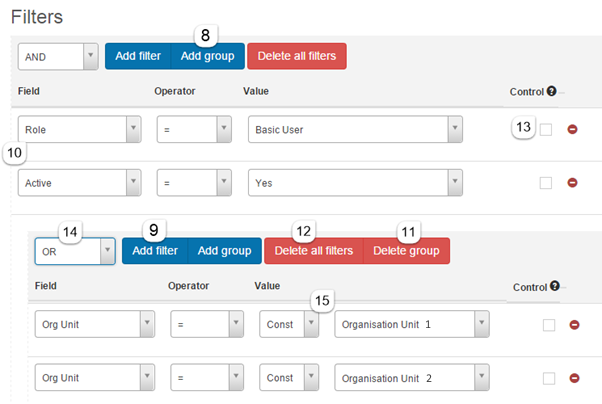Welcome to the Janison Academy help portal
Settings
You can set up rules to precisely define parts of a CLS entity. These rules are called filters in the CLS They can very precisely select members of an entity because they are combined using Boolean logic, which can also be nested. This will be best understood by someone who is comfortable with:
If you understand these go straight to Filter Building, otherwise start with Concepts – Easier Introduction to Filters .
Consider a group of items with different colours and labels:

If we select all the items that have the number 2 we would only see:

The CLS expresses this kind of selection as a filter, which is another name for a logic rule. In the screenshot below we have entered a rule (filter) that Number = 2. You can see it at the bottom part of the image. You can ignore the rest of the image, for now…

Filters can be applied to CLS entities in a number of contexts. This explanation uses the example of reporting on the Users entity. We are building a set of rules and combining them together logically in order to select certain Users.
To build a filter:

Thus, the screenshot above shows a set of rules that when applied to Users selects those who:
Extra Note about Values (4). In some cases, for example when you have specified that “Active =”, you will be provided with drop-down choices, in this case yes or no.
In other cases, for example when you have specified that “Org Unit =“ (see 15 in the screenshot below), an additional drop-down box will appear with Const and Param as choices. You select Const to indicate that you are specifying a value in the right hand box; you select Param to indicate that you are specifying a characteristic in the right hand box.
In this example, choosing Const means that the box displays actual Org Units to select. Selecting Param means that you can choose a relationship, i.e. your own Org Unit.

This functionality, which can be repeated and combined numerous times and ways, means that rules can be nested in rules that are nested and combined in rules, and so on, leading to highly detailed specifications. As discussed, these are best set up by people, such as programmers, who can design the nested IF statements required.
Thus, the screenshot above now selects those Users who:
For another example of a targeted set of filters, the screenshot below specifies all Users who:

Note that if the top level field (marked A) was set to “AND” instead of “OR”, then the only User(s) selected would:
A Filter item takes a Property, an Operand and a Value to compare with. The Property is either a property available directly on the entity (e.g. User’s Last Name), or a Custom Attribute. The following properties are available to participate in filtering at the User level (note that for brevity, standard built-in properties are not included):
Operands are the logical operations. Depending on the datatype of the Filter Property, different operands are available. For example ‘contains’ cannot operate on a Date Type, but it can operate on a Text String. Below are the operands available:
The Value to compare with appears in the third column, and changes its input control depending on the data type. For example, for Date Types, it would show a date picker, and for Text it would show a text box. This is the value that the report will use in the filter item to compare with.
Some data types support parametric comparison values rather than explicit values. For example, it’s often useful to run a report of Users that logged on during the last week. Rather than selecting a ‘hard’ date (which would need to be updated each time a report is run), it’s possible to select a parameter: “during the last week”. At the time of writing, parametric comparison values are only available for Date Type properties, with the following parameters supported:
Note that in addition to the filters specified, the system will append further filters based on Security roles of the User who is logged in.
1300 857 687 (Australia)
+61 2 6652 9850 (International)
ACN 091 302 975
ABN 35 081 897 494
© 2024 Janison
Janison acknowledges the traditional owners of the land on which we work and meet. We acknowledge the continuous care of the land, animals and waterways. We pay our respects to Elders past, present and emerging.